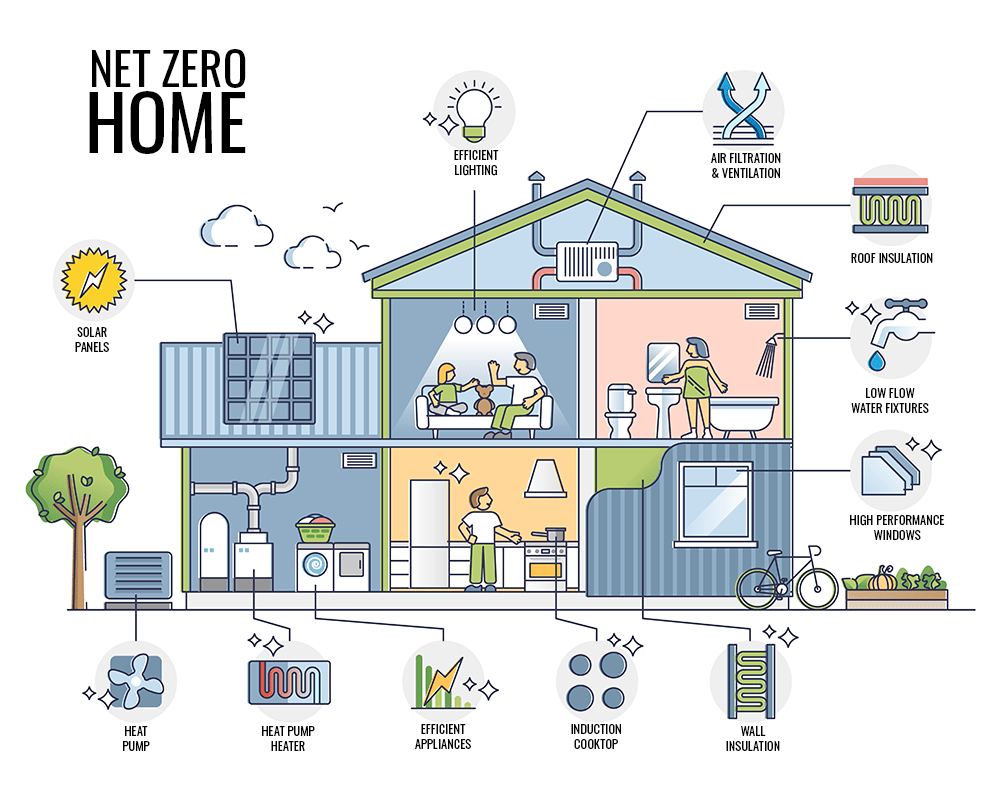Redefining Sustainable Living
As the world moves towards a greener and more sustainable future, net-zero homes are emerging as the epitome of energy-efficient and environmentally conscious living. In British Columbia, a province renowned for its commitment to sustainability, net-zero homes are paving the way for a greener way of life. In this blog, we will explore what net-zero homes are, their benefits, and how they are revolutionizing the housing industry in British Columbia.
- What is a Net-Zero Home? A net-zero home is a building that generates as much energy as it consumes over a year, resulting in a net-zero carbon footprint. These homes combine high-performance building design, energy-efficient features, and renewable energy systems to achieve exceptional energy performance. They are designed to reduce energy consumption through insulation, air sealing, and energy-efficient appliances, while generating renewable energy through solar panels, wind turbines, or geothermal systems.
- Energy Efficiency at Its Core Net-zero homes in British Columbia are designed with a strong emphasis on energy efficiency. They incorporate advanced building envelope systems, such as superior insulation, airtight construction, and high-performance windows, to minimize heat loss or gain. Energy-efficient appliances, LED lighting, and smart energy management systems further optimize energy consumption. By significantly reducing energy demand, net-zero homes decrease reliance on the grid and fossil fuels.
- Renewable Energy Integration To achieve net-zero status, these homes go beyond energy efficiency by incorporating renewable energy generation systems. Solar photovoltaic (PV) panels are the most common choice in British Columbia, harnessing the region’s abundant sunlight. These systems convert solar energy into electricity, which can power the home’s electrical needs and even feed surplus energy back into the grid. Other renewable energy sources, such as wind turbines or geothermal heat pumps, may also be utilized, depending on the home’s location and design.
- Healthier and More Comfortable Living Spaces Net-zero homes in British Columbia prioritize indoor air quality and occupant comfort. Proper ventilation systems, such as heat recovery ventilators (HRVs), ensure a continuous supply of fresh air while recovering heat from outgoing stale air. Additionally, high-quality insulation, efficient HVAC systems, and triple-pane windows create a comfortable indoor environment year-round. Net-zero homes also reduce the risk of drafts, temperature fluctuations, and moisture-related issues, providing a healthier living space for occupants.
- Environmental and Economic Benefits Net-zero homes offer significant benefits for both the environment and homeowners. By minimizing greenhouse gas emissions and reducing reliance on fossil fuels, these homes contribute to mitigating climate change and preserving the environment. Homeowners can enjoy substantial energy savings, as net-zero homes drastically reduce or eliminate energy bills. Furthermore, British Columbia offers various incentives and rebates, such as the BC Energy Step Code and federal grants, to encourage the construction of net-zero homes, making them financially appealing.
Net-zero homes in British Columbia are at the forefront of sustainable living. Combining energy efficiency, renewable energy integration, and advanced building design, these homes redefine how we interact with our environment and utility systems. By striving towards net-zero energy consumption, homeowners can reduce their environmental footprint, enjoy energy savings, and create a healthier and more comfortable living environment. As the demand for sustainable housing grows, net-zero homes in British Columbia continue to inspire and pave the way for a greener future.
.

